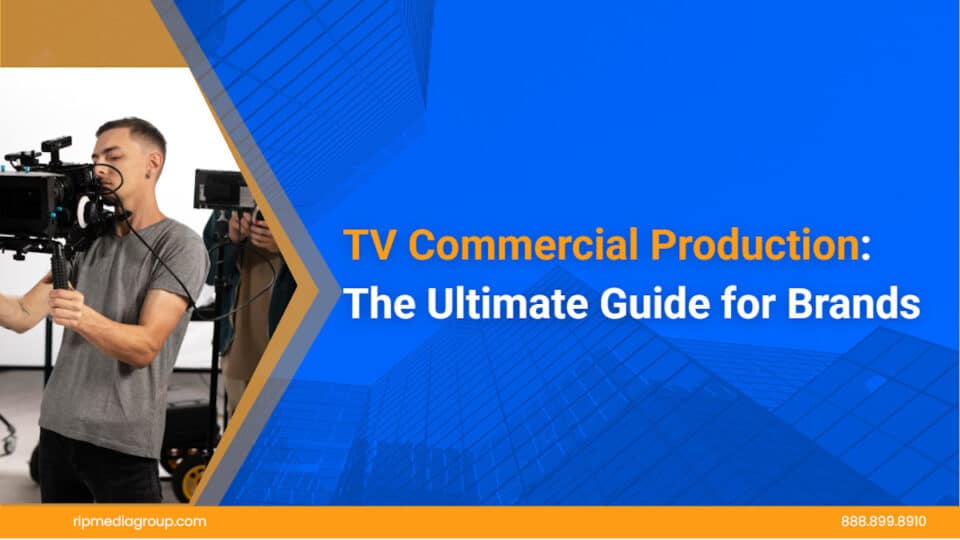TV commercial production remains one of the most effective ways to build brand awareness and drive sales. Even in the era of digital advertising, businesses still invest heavily in TV ads because they deliver strong visibility and credibility. If you want your brand to reach millions with impact, understanding TV commercial production is essential.
This guide explains every stage of TV commercial production, from concept development to post-production, and why it continues to play a key role in marketing strategies today.
1. What Is TV Commercial Production?
TV commercial production refers to the process of creating a television advertisement from idea to final broadcast. It involves several stages—strategy, scripting, storyboarding, filming, and editing, each with a direct impact on the final result.
Unlike online ads, TV commercials must meet specific technical and creative standards. They also require precise timing, often 15, 30, or 60 seconds. The challenge is to deliver a clear message and emotional connection in a short amount of time.
2. Why TV Commercials Still Matter
TV still reaches millions of viewers daily. According to Nielsen, over 70% of adults in the U.S. watch traditional TV weekly, and advertising on it continues to influence purchasing decisions.
A well-produced TV commercial can:
- Build trust faster than digital-only campaigns.
- Create a sense of legitimacy and prestige for your brand.
- Deliver consistent exposure when aired repeatedly.
Even major online brands like Amazon, Google, and DoorDash invest in TV commercial production because it drives awareness at scale.
3. The Key Stages of TV Commercial Production
Let’s break down the process so you know what to expect.
a. Strategy and Creative Brief
Every project starts with understanding your goals. What’s the purpose of the ad? Who are you targeting? What action do you want viewers to take?
Your creative brief should define:
- The target audience
- The key message
- The desired tone and visual style
- The distribution plan
A clear brief guides every decision during TV commercial production and avoids wasted time or revisions.
b. Scriptwriting
Once your goals are defined, it’s time to craft the script.
A good TV script is short, visual, and focused. Every second counts.
The script must include dialogue, visuals, and voice-over cues. It’s also where brand personality takes shape. The difference between a forgettable commercial and one that converts often comes down to how well the script connects emotionally with the audience.
c. Storyboarding
Storyboarding translates your script into visuals. It outlines each shot, scene, and transition. This step ensures everyone—from the client to the director—understands the creative vision before filming starts.
In professional TV commercial production, storyboards help avoid costly surprises on set.
d. Casting and Location Scouting
Casting determines who represents your brand. Whether you use actors or real customers, the people in your commercial should reflect your target audience and reinforce your message.
Choosing the right location matters too. A single setting can define the tone of the ad—corporate, lifestyle, or cinematic.
e. Filming
Filming is where the concept becomes real. High-quality equipment, lighting, and sound make the difference between an amateur ad and a professional production.
A skilled crew handles each element with precision. Directors focus on performance and pacing, while cinematographers ensure visual consistency.
Time on set is expensive, which is why experienced TV commercial production teams plan every shot in advance.
f. Post-Production
Post-production includes editing, sound design, voice-over recording, and color correction. This is where the final commercial comes to life.
Editing shapes the rhythm. Music adds emotional tone. Graphics and text reinforce key points. Every second must contribute to the story and keep the viewer engaged.
At this stage, teams also create different versions for multiple platforms—TV, streaming, and social—to maximize reach.
4. Budgeting for TV Commercial Production
Costs vary based on duration, talent, and complexity. A simple spot can cost around $10,000, while national campaigns can exceed $100,000.
Budgeting tips:
- Allocate at least 30% for production (filming and editing).
- Reserve funds for post-production and licensing (music, footage, or talent).
- Plan media buying separately from production.
The best way to control costs is by working with a production company that manages both creative and logistics efficiently.
5. Measuring the Impact of a TV Commercial
After your ad airs, it’s important to measure results.
Key metrics include:
- Reach and frequency (how many people saw your ad)
- Brand recall and recognition
- Sales lift after airing
Today, data tools can track the effect of TV ads across digital channels. For example, you can see how web traffic or app downloads increase after a TV campaign runs.
Brands that combine TV commercial production with digital analytics gain a full view of performance.
6. Examples of Successful TV Commercials
- Apple – “Shot on iPhone”: Simple visuals and real user footage made this campaign relatable and powerful.
- Nike – “Dream Crazy”: A strong message and high-quality production reinforced brand values and created cultural impact.
- Geico – “15 Minutes Could Save You 15%”: Consistent tone, humor, and message turned it into one of the most recognizable campaigns ever.
Each of these campaigns reflects what great TV commercial production achieves—clarity, emotion, and memorability.
7. How to Choose the Right Production Partner
Selecting the right partner can define the success of your project. Look for:
- Proven experience in TV commercial production
- Strong storytelling and creative direction
- Full-service capabilities (from concept to post-production)
- Positive client testimonials and case studies
Ask for examples of similar work and discuss your goals clearly. The right team will turn your brand vision into a high-impact visual message.
8. The Future of TV Commercials
While streaming platforms and social media continue to grow, TV remains one of the most trusted advertising channels. The line between traditional and digital video is also blurring—many brands now produce commercials that air across both.
In 2025 and beyond, TV commercial production will continue to evolve with AI tools, virtual sets, and data-driven storytelling. But the fundamentals remain the same: clear messaging, emotional resonance, and professional execution.
Conclusion
TV commercial production is more than filming an ad. It’s a process that combines strategy, storytelling, and technical precision to connect your brand with millions of viewers.
When done right, it builds awareness, drives conversions, and strengthens brand credibility.
If you want to create a professional, high-impact commercial for your brand, Rip Media Group offers industry-leading expertise in strategy, creative direction, and production.
👉 Partner with Rip Media Group today to bring your next TV commercial to life with clarity, quality, and measurable results.


